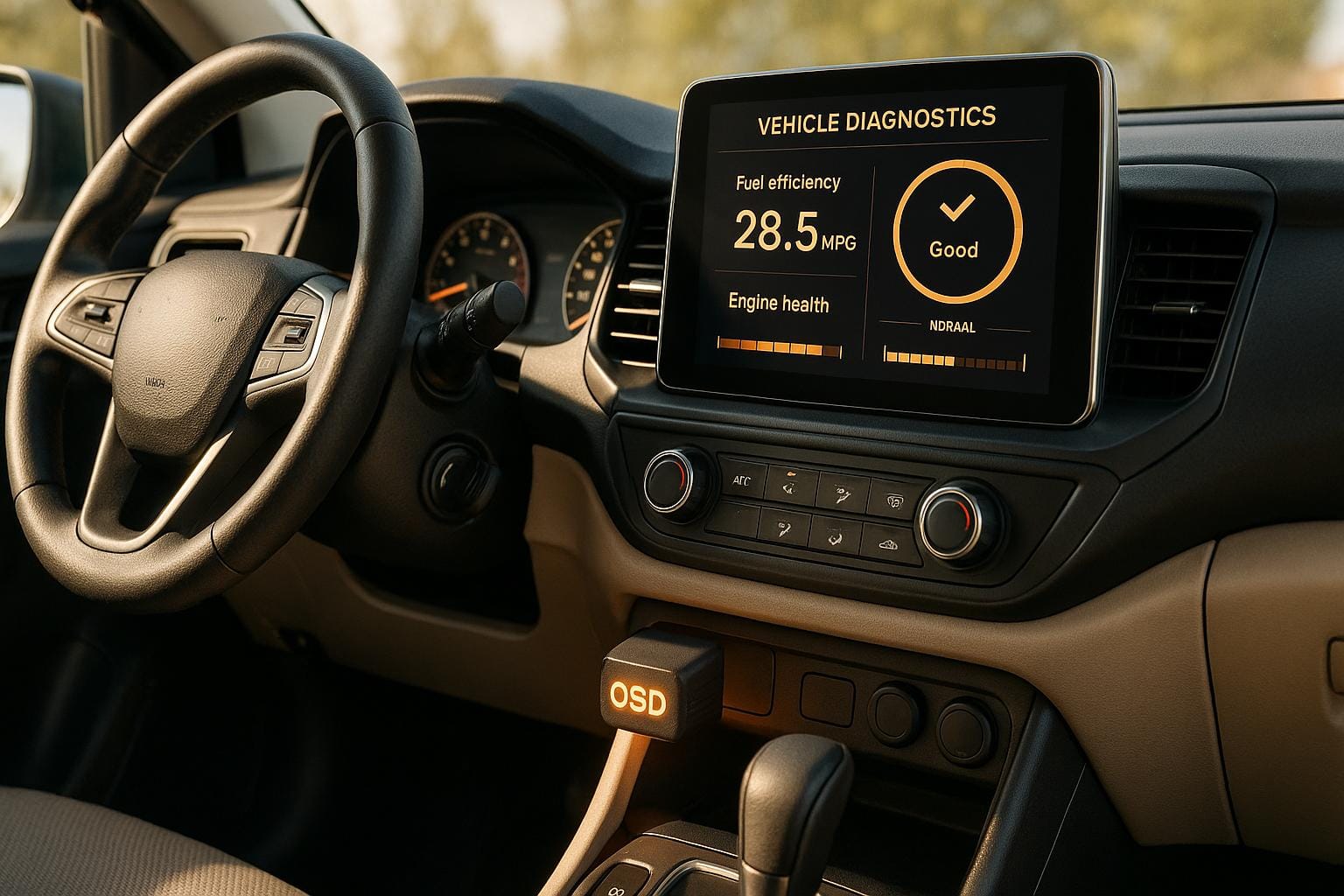Fleet incident reporting is critical for reducing costs, improving safety, and ensuring compliance. Here's a quick summary of the key takeaways:
- Why It Matters: One-third of road collisions in the UK involve work drivers. Delayed or inaccurate reporting can increase insurance claim costs by 30% and lead to legal and financial risks.
- Common Problems: Late notifications, missing or incorrect data, and lack of driver engagement are the biggest challenges.
- Solutions:
- Clear Procedures: Use simple checklists and laminated cards to guide drivers.
- Driver Engagement: Train drivers, reward timely reporting, and create a blame-free culture.
- Technology: Real-time telematics systems provide instant data, reducing delays and costs.
Quick Comparison of Reporting Methods
| Method | Pros | Cons | Best For |
|---|---|---|---|
| Telephone Reporting | Familiar; offers human support | Slower; potential inconsistencies | Backup method |
| Mobile Apps | Real-time reporting; GPS/photo capture | Requires training; initial setup costs | Modern fleets |
| Manual Forms | Low cost | High error rates; slow processing | Not recommended |
| Hybrid Approach | Combines strengths of multiple methods | Requires coordination | Most UK fleet operations |
Key Benefits of Real-Time Telematics
- Faster Responses: Instant alerts and automatic crash notifications.
- Improved Accuracy: Detailed data reduces disputes and speeds up claims.
- Cost Savings: Up to 25% reduction in operational costs and fewer preventable accidents.
Takeaway: Clear processes, driver engagement, and real-time technology are the keys to better incident reporting. Equip your fleet with tools like GRS Fleet Telematics to transform how incidents are managed.
Incident reporting and investigation
Common Problems in Fleet Incident Reporting
Fleet managers across the UK often encounter challenges with incident reporting, which can turn minor issues into major financial and safety concerns. Key areas of difficulty include delayed notifications, incomplete data, and driver engagement.
Late Incident Notifications
Delays in reporting incidents can have a significant financial impact. For instance, claims reported more than 24 hours after an incident can cost thousands of pounds more, with delayed reporting leading to a 30% increase in claim costs. On average, claims reported by email take 18 days to process. These delays are often tied to outdated systems reliant on paperwork and manual data entry. Driver-related factors, such as stress or language barriers, can further slow the process.
Some companies have addressed this issue effectively. Take Voi, an e-mobility operator, as an example. By submitting 67% of claims within 24 hours, they reduced their average claim cost from £6,768 in Q1 2024 to £1,974 by Q4 2024 [Flock Fleet Insurance, 2025].
Missing or Wrong Data Collection
Accurate and complete data is essential for resolving incidents efficiently. Missing or incorrect details in reports can lead to delays in insurance claims, vehicle repairs, and overall operations. Stress, time constraints, or insufficient training often contribute to these data gaps. Insurers require comprehensive information to process claims, and when it’s incomplete, the entire process slows down.
Beyond financial delays, poor data collection can pose safety risks. For example, transportation incidents accounted for 40% of workplace fatalities three years ago. Regulatory compliance also suffers without proper record-keeping. Violations related to driver logs and hazardous materials transportation increased from £14.4 million in 2016 to £16.5 million in 2017.
Driver Training and Participation Issues
Another persistent challenge is getting drivers to actively engage in reporting. Fear of blame or disciplinary action often discourages timely and accurate reporting. Concerns about job security or being held responsible can lead to hesitation. Additionally, some experienced drivers resist adopting new reporting systems, while others on tight schedules may view reporting as an inconvenience.
To address this, fleet managers need to shift the narrative around incident reporting. Emphasising that the process is about improving safety and supporting drivers - not punishing them - can help. Some fleets have had success by rewarding drivers who maintain low-risk profiles or actively participate in safety initiatives. Training programmes that showcase the benefits of timely and accurate reporting - such as smoother insurance claims and stronger legal protection - can also make a difference. Regular safety meetings that encourage open dialogue can foster a sense of teamwork and mutual commitment to safety.
The goal is to create systems that are easy to use and stress-free while promoting a culture where safety is prioritised over fault-finding.
Best Practices for Better Fleet Incident Reporting
Tackling challenges in fleet incident reporting requires clear processes, driver involvement, and the smart use of technology. By following these practices, fleet managers can cut down on delays and improve data accuracy.
Create Clear Reporting Procedures
The backbone of effective incident management is having well-defined reporting policies. When procedures are straightforward, everyone knows what steps to take when an incident occurs, enabling quicker responses.
"Clear and concise procedures will help ensure drivers understand the expectations placed upon them, how to report incidents, the steps to take to address maintenance issues, and the importance of risks such as speeding, fatigue, and driver distraction." – Marsh LTD
Your procedures should specify what details drivers need to gather at the scene, such as the circumstances of the incident, witness information, the number of injuries or passengers, involvement of police, vehicle speeds, stolen items, third-party contacts, and weather conditions. A simple checklist can make this process easier.
Drivers should also know how and when to report incidents. Laminated reference cards kept in vehicles can be a handy tool, outlining these steps along with emergency contact numbers and insurance details.
Incident reporting is just one part of broader fleet safety compliance, which also includes vehicle maintenance schedules, driver training, and regulatory requirements. By integrating these aspects into your reporting framework, you create a system that supports both immediate responses and long-term safety goals. With clear guidelines, consistent and timely reporting becomes second nature.
Get Drivers to Report Incidents Immediately
Encouraging drivers to report incidents as soon as they happen is essential for reducing costs and collecting accurate information. Achieving this relies on creating a simple reporting system and fostering a supportive environment.
Strong communication is key. Drivers are more likely to report incidents promptly when they understand the benefits, such as legal protection and quicker issue resolution. Make it clear that reporting isn’t about assigning blame but about ensuring safety and efficiency.
Training first-line managers can also make a big difference. These managers, who interact directly with drivers, can emphasise the importance of immediate reporting and provide reassurance to drivers who may feel anxious after an incident.
Incentives can also help. Rewarding quick and thorough reporting encourages participation. Additionally, equipping drivers with tools like digital forms and photo upload features simplifies the process, removing barriers to immediate action. With prompt reporting, fleets can leverage real-time data for quicker interventions.
Use Technology for Real-Time Reporting
Modern telematics systems have revolutionised incident reporting, turning what used to be a manual, time-consuming task into a streamlined, automated process. These systems gather critical data - such as speed, braking, and location - at the time of an incident, offering solid evidence for insurance claims and accurate timelines.
Take the example of Fleet Service GB, which showcased the effectiveness of tech-based reporting in January 2025 with their Achieve Driver App. The app not only collects incident data but also analyses it to identify trends and suggest improvements in driver behaviour, vehicle maintenance, or operations.
GRS Fleet Telematics provides another advanced solution, using dual-tracker technology to monitor incidents in real time and notify fleet managers instantly. This eliminates the delays often associated with manual reporting.
Some systems go even further with AI-driven tools that can reconstruct incidents on a map, cutting reporting times by as much as 60%. They also boost operational efficiency by 25% and speed up dispute resolutions by 25%. Features like automatic crash notifications and integrated dashcams add another layer of detail, helping resolve claims faster and determining liability with greater accuracy. These systems can even predict accident severity and alert emergency services based on vehicle velocity and GPS data.
Fleets that adopt telematics often see measurable benefits. Reports show a 15–20% reduction in fuel costs and up to an 8% decrease in preventable accidents when driver safety scores improve by just 10%.
Faster Response Times with Real-Time Telematics Systems
When something goes wrong, every second matters. Real-time telematics systems speed up emergency responses by delivering instant alerts and capturing detailed data, enabling quick, well-informed decisions.
Real-Time Alerts and Automatic Data Capture
Modern telematics systems work around the clock, monitoring your fleet and gathering critical information the moment an incident occurs. They track everything from vehicle location and speed to driving behaviours like harsh braking or acceleration, as well as engine diagnostics, with updates every 30 seconds.
These systems can immediately notify fleet managers when a vehicle exceeds speed limits, enters or exits geofenced zones, or experiences sudden impacts. For example, United Vision Logistics found this real-time monitoring incredibly valuable, as it drastically streamlined their response process.
"Having everything right there - the accident location, GPS coordinates, the video, and my driver's number - was invaluable to us." - Ryan Domengeaux, Chief Legal Officer, United Vision Logistics
GRS Fleet Telematics takes this a step further by employing dual-tracker technology. If the primary tracker is damaged during an incident, a secondary Bluetooth backup ensures the data keeps flowing. This uninterrupted stream of information not only alerts managers but also provides the foundation for quick, informed decisions.
Smarter Decisions and Faster Recovery
Real-time telematics systems don't just send alerts - they also transform how post-incident decisions are made. With immediate access to accurate data, managers can assess situations within minutes, instead of waiting hours or days for driver reports. This allows them to deploy the right resources without delay.
The detailed data also improves resource allocation. Fleet managers can quickly decide whether to send a replacement vehicle, arrange roadside assistance, or call emergency services. This kind of speed has real-world benefits: Estes Forwarding Worldwide reported an 81% reduction in insurance claims by leveraging real-time telematics.
"Without Motive, it would have taken us days to figure out that the vehicle had been abandoned and where it was. With Motive, we knew right where it was and could retrieve it right away." - Karol Smith, Director of Transport Safety, Estes Forwarding Worldwide
The financial impact is just as impressive. United Vision Logistics saved millions in litigation and downtime costs thanks to instant access to crucial incident data. GPS data, video evidence, and precise timing details not only speed up dispute resolution but also help combat fraudulent claims.
Real-time data also minimises disruptions by enabling faster resource deployment. Over time, it can reveal patterns - like recurring issues with certain routes, drivers, or vehicle types - allowing managers to implement preventive measures and reduce future incidents.
Fleets equipped with advanced telematics systems consistently report faster response times and noticeable improvements in safety performance.
Incident Reporting Methods: Pros and Cons
Choosing the right method for incident reporting can significantly improve efficiency and ensure drivers can report incidents quickly and effectively. Each method has its own strengths and weaknesses, so understanding these differences is key to making the best choice for your fleet operations.
Telephone reporting is a method many drivers are already comfortable with. When an incident happens, drivers can call a dedicated hotline and speak directly with trained agents. This human interaction can be particularly helpful for drivers who are feeling shaken or stressed. As Jim Monteith from RAC explains:
"Accident management providers will employ service centre agents who are trained to deal with distressed drivers. They spend adequate time with each driver to accurately capture incident detail, assess liability, and to understand potential indemnity restrictions, whilst providing re-assurances following nasty accidents."
However, this method isn't without its drawbacks. Telephone reporting can result in inconsistencies, relies heavily on manual data entry, and is generally slower than digital alternatives.
On the other hand, mobile apps and digital solutions have revolutionised incident reporting. These tools allow drivers to report incidents directly from the scene, capturing photos, GPS data, and other critical details instantly. The benefits are clear: faster reporting and significant cost savings, with studies showing an average saving of £1,500 per at-fault claim.
To help compare these methods, here’s a breakdown of their key features:
Comparison Table of Reporting Methods
| Method | Advantages | Disadvantages | Response Time | Accuracy | UK Fleet Suitability |
|---|---|---|---|---|---|
| Telephone Reporting | Familiar to drivers; trained agents provide reassurance; immediate human contact | Potential inconsistencies; manual data entry required; slower overall process | Moderate | Good | Suitable as a backup method |
| Mobile Apps (eNOL) | Real-time reporting; instant photo uploads; GPS integration; automated data capture | Requires driver training; potential technical issues; initial setup costs | Excellent | Very high | Highly recommended |
| Manual Forms | Low initial cost; familiar process | Slow processing; high error rates; delayed response; manual data entry | Poor | Low | Not suitable for modern operations |
| Hybrid Approach | Combines benefits of multiple methods; maximises accessibility and fallback options | - | Excellent | Very high | Optimal for most UK fleets |
These comparisons underline why digital tools are becoming the go-to choice for incident reporting. Not only do they offer faster response times, but they also deliver considerable cost savings. For example, RAC research shows that controlled third-party claims cost around £1,800, compared to £4,000 for non-controlled claims.
Callum Langan from sopp+sopp highlights the importance of speed and accuracy in incident reporting:
"The faster and more accurately you're notified of incidents after they occur, the more effectively you can respond to mitigate the associated risks, and promote positive, well-managed outcomes."
Many UK fleets are now adopting a hybrid approach, which combines the strengths of digital reporting with the reliability of telephone backup. This strategy ensures drivers always have a way to report incidents, whether they face technical issues or simply prefer speaking to someone. To make the process even smoother, providing drivers with at-scene bump cards containing essential information can help ensure reports are consistent and complete every time.
Conclusion: Key Points for Better Incident Reporting
Improving fleet incident reporting relies on a well-rounded approach that combines clear policies, engaged drivers, and cutting-edge telematics. Insights from sopp+sopp, based on over 100,000 fleet incidents, reveal that effective communication with drivers and timely reporting have the biggest impact on claim outcomes.
The most successful fleets in the UK recognise that driver engagement is the cornerstone of efficient incident reporting. By focusing on supporting drivers rather than assigning blame, organisations can significantly enhance the quality and speed of reports. As Rick Wood from RoSPA puts it:
"There can be a positive change in culture if investigations are carried out with transparency and without blame."
This driver-first strategy works hand in hand with modern technology, making the reporting process even smoother. Advanced telematics systems, such as those from GRS Fleet Telematics, offer real-time data collection and automated reporting, which are essential for today’s fleets. With 38% of UK companies now using telematics in their operations, the benefits are clear. Nick Walker from RAC Telematics underscores this point:
"Telematics provides an immediate solution by generating data that can prove beyond doubt what actually happened during the incident."
The combination of proper driver training and telematics delivers impressive results. For example, 72% of fleets report fewer crashes and claims, while 25% have seen reduced insurance premiums. BT Group is a standout example, achieving a 50% drop in accidents over the last decade through consistent data-driven analysis.
Speed is crucial when it comes to incident reporting, and telematics systems shine here by providing instant alerts and automatic data collection, cutting out delays. For UK fleets aiming to refine their incident reporting, the focus should be on three key areas: implementing straightforward procedures for drivers, adopting real-time reporting technology, and fostering a supportive environment where drivers can report incidents without fear of repercussions.
When these elements come together, they create a strong foundation for fleet safety. Solutions like GRS Fleet Telematics, with advanced tracking options starting at just £7.99 per month, enable UK fleets to shift from a reactive approach to a proactive one, transforming the way incidents are managed.
FAQs
How do real-time telematics systems help reduce costs from delayed incident reporting?
Real-time telematics systems can dramatically cut costs linked to delayed incident reporting by enabling instant detection and verification of incidents. This means quicker response times, less vehicle downtime, and a reduced risk of minor issues spiralling into major problems.
By acting swiftly, fleet managers can manage accidents more effectively, keeping expenses like vehicle repairs, insurance claims, and operational disruptions in check. Plus, with real-time monitoring encouraging safer driving habits, these systems can help reduce accident rates, saving even more money in the long run.
For UK businesses, investing in advanced telematics solutions such as GRS Fleet Telematics offers more than just faster response times. With features like dual-tracker technology and pricing as low as £7.99 per month, it also provides enhanced security and cost efficiency.
How can businesses encourage drivers to actively participate in fleet incident reporting?
Encouraging drivers to report fleet incidents effectively begins with offering straightforward, user-friendly tools. Digital platforms that let drivers log incidents immediately can boost both participation and the accuracy of reports. To make these tools more effective, they should be intuitive and optimised for mobile devices.
Equally important is fostering a safety-first mindset built on trust. Communicating why incident reporting matters, involving drivers in creating safety policies, and acknowledging their contributions can go a long way. When drivers feel their input is respected and valued, they are much more likely to take an active role.
By pairing practical tools with a supportive and inclusive approach, companies can simplify the reporting process and improve fleet safety overall.
Why is a hybrid incident reporting system ideal for UK fleet operations, and how does it work?
Why a Hybrid Incident Reporting System Works for UK Fleets
A hybrid incident reporting system brings together the best of both worlds - modern digital tools and traditional methods - making it a smart choice for UK fleet operations. By integrating mobile apps with telephone reporting systems, fleet managers can ensure incidents are logged both quickly and accurately.
This dual approach offers the speed and convenience of real-time digital reporting while keeping the familiarity of phone-based methods intact. It makes it easier for drivers and managers to report and manage incidents effectively. Plus, it enhances compliance, improves communication, and shortens response times - all critical for ensuring safety and efficiency in fleet operations across the UK.




